CT colonography in cancer detection: methods and results
- PMID: 18215973
- PMCID: PMC1435345
- DOI: 10.1102/1470-7330.2004.0014
CT colonography in cancer detection: methods and results
Abstract
Colon cancer is the second leading cause of cancer-related death in the Western world. Approximately 80-90% of colon cancers develop in adenomas after mutations. The risk of encountering malignancy increases with the size of the adenomatous polyp. It is approximately 1% in adenomas <1 cm, and increases to 10% for adenomas 1-2 cm, and 20-53% for adenomas >2 cm. CT colonography (CTC) is a new technique, which allows, after bowel preparation and distension of the cleansed colon, to generate a volumetric display of the colon. Multi-detector CTC has a sensitivity of 93-100% and 70-83% for detection of polyps sized >=10 mm and 6-9 mm, respectively. For detection of colorectal cancer, CTC has a sensitivity of 83-100%. CTC is especially of value in patients with incomplete colonoscopy due to stenosis or colon elongation. It reliably detects synchronous cancers proximal to occlusive colon cancers, when colonoscopy fails to evaluate the entire colon. First results of a colon cancer screening study have shown that CTC is equal or even slightly superior to conventional colonoscopy in detection of adenomatous polyps >=8 mm. Moreover, CTC detects clinically significant extracolonic abnormalities not shown by colonoscopy. To increase the patient acceptance for wide-spread application of CTC cancer screening the issue of patient discomfort by bowel preparation and radiation exposure needs to be addressed further.
Figures

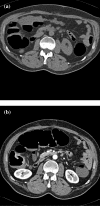
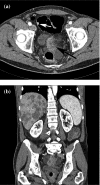
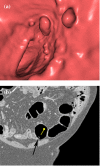


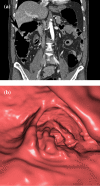

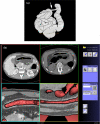
Similar articles
-
Computed tomographic colonography (CTC): Possibilities and limitations of clinical application in colorectal polyps and cancer.Technol Cancer Res Treat. 2004 Apr;3(2):201-7. doi: 10.1177/153303460400300213. Technol Cancer Res Treat. 2004. PMID: 15059026 Review.
-
Clinical Value of CT Colonography Versus Preoperative Colonoscopy in the Surgical Management of Occlusive Colorectal Cancer.AJR Am J Roentgenol. 2018 Feb;210(2):333-340. doi: 10.2214/AJR.17.18144. Epub 2017 Dec 20. AJR Am J Roentgenol. 2018. PMID: 29261351 Free PMC article.
-
Computed Tomography Colonography vs Colonoscopy for Colorectal Cancer Surveillance After Surgery.Gastroenterology. 2018 Mar;154(4):927-934.e4. doi: 10.1053/j.gastro.2017.11.025. Epub 2017 Nov 22. Gastroenterology. 2018. PMID: 29174927 Free PMC article. Clinical Trial.
-
Performance of a previously validated CT colonography computer-aided detection system in a new patient population.AJR Am J Roentgenol. 2008 Jul;191(1):168-74. doi: 10.2214/AJR.07.3354. AJR Am J Roentgenol. 2008. PMID: 18562741
-
Colon Capsule Endoscopy vs. CT Colonography Following Incomplete Colonoscopy: A Systematic Review with Meta-Analysis.Cancers (Basel). 2020 Nov 13;12(11):3367. doi: 10.3390/cancers12113367. Cancers (Basel). 2020. PMID: 33202936 Free PMC article. Review.
Cited by
-
CT colonography for synchronous colorectal lesions in patients with colorectal cancer: initial experience.Eur Radiol. 2010 Mar;20(3):621-9. doi: 10.1007/s00330-009-1589-x. Epub 2009 Sep 2. Eur Radiol. 2010. PMID: 19727743
-
Patient satisfaction with colonoscopy: a literature review and pilot study.Can J Gastroenterol. 2009 Mar;23(3):203-9. doi: 10.1155/2009/903545. Can J Gastroenterol. 2009. PMID: 19319384 Free PMC article. Review.
References
-
- Weitz J, Schalhorn A, Kadmon M, Eble MJ, Herfarth C. Kolon-und Rektumkarzinom. In: Hiddemann W, Huber H, Bartram C, editors. Die Onkologie, Teil 2. Berlin: Springer; 2004. pp. 875–932.
-
- Rustgi A, Crawford JM eds. Gastrointestinal Cancers. Edinburgh: Saunders; 2003. p. 435.
-
- Winawer SJ, Zauber AG, Ho MN , et al. Prevention of colorectal cancer by colonoscopic polypectomy. N Engl J Med. 1993;329:1977–81. - PubMed
-
- Heiken JP. Colon cancer screening. Cancer Imaging. 2001;2:10–14.
-
- Fenlon HM, Nunes DP, Schroy PC III, Barish MA, Clarke PD, Ferrucci JT. A comparison of virtual and conventional colonoscopy for the detection of colorectal polyps. N Engl J Med. 1999;341:1496–503. - PubMed
LinkOut - more resources
Full Text Sources
